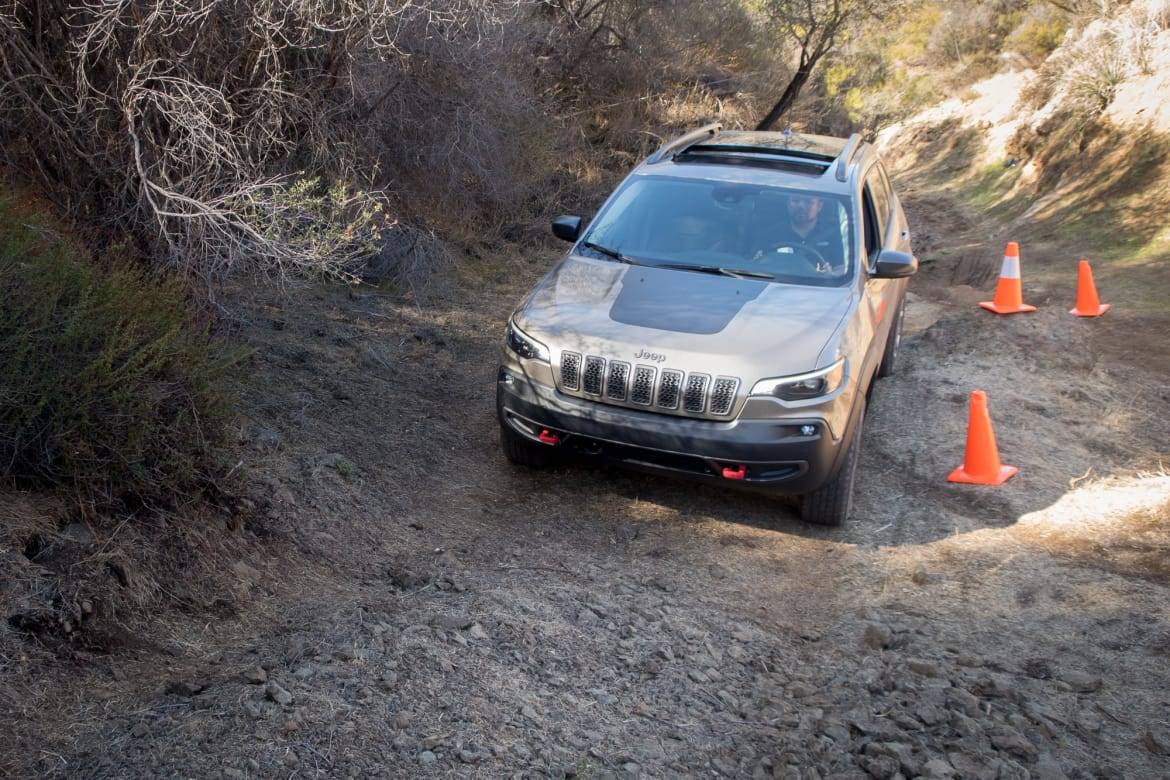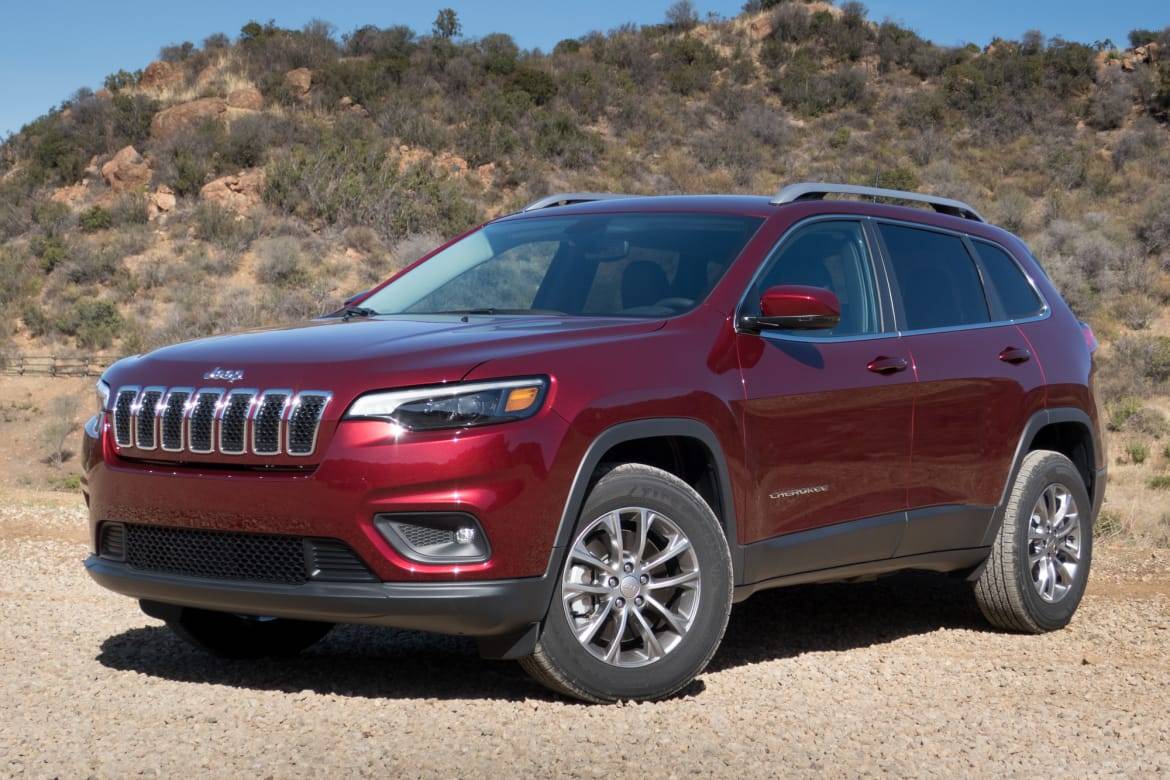
Just one week after the updated 2019 Jeep Cherokee made its debut at the 2018 Detroit auto show, I got the chance to get behind the wheel to see how those changes translate to the road.
Related: Jeep Puts Best Face Forward With 2019 Cherokee Redesign
Our preview has a more detailed rundown of the 2019 Cherokee’s changes, which are comprehensive. The exterior styling has been reworked to make the Cherokee appear more conventionally Jeep-esque, similar to the Compass and Grand Cherokee. There is also updated technology, improved cabin materials and a brand-new optional engine.
The changes are nice, but what held the previous model back in my mind was value. It was just too expensive to compete with like-sized and -featured competitors. Along with a chance to get behind the wheel, Jeep also announced pricing for the Cherokee’s five trim levels (Latitude, Latitude Plus, Limited, Overland and Trailhawk).
Engine Upgrade
The Cherokee’s most exciting addition is under the hood. Joining the two carryover engines from last year is a new turbocharged 2.0-liter four-cylinder (out of the Alfa Romeo Giulia) that makes 270 horsepower and 295 pounds-feet of torque. The other two engines are a 180-hp, 2.4-liter four-cylinder making 171 pounds-feet of torque and a 271-hp, 3.2-liter V-6 making 239 pounds-feet of torque. All three engines are mated to a nine-speed automatic transmission.
Jeep has greatly expanded the Cherokee’s engine availability for 2019: The 2.4-liter four-cylinder serves as the base engine for the Latitude, Latitude Plus and front-wheel-drive versions of the Limited. The V-6 is optional on all those trim levels and standard on the all-wheel-drive Limited, Overland (4×2 and 4×4) and Trailhawk. And the new turbocharged four-cylinder is optional on all trim and drivetrain configurations except for the Latitude.
I drove models with the V-6 and the turbo-four, and there was a stark difference between the two. The torque advantage of the turbo-four is apparent; it’s much quicker and more responsive than the V-6 (which admittedly felt muted to me when I drove it in the previous-generation Cherokee as well).
It’s too bad that the transmission doesn’t keep up with the engine; the nine-speed is a wet blanket and forms a fun-barrier between the driver and the quick acceleration the engine is capable of providing. After a year of 2014 Cherokee ownership by Cars.com, it was the balky transmission that soured our staff on the model, though it was clear the base four-cylinder was part of the problem and the V-6 made the transmission at least tolerable.
The transmission, combined with a good amount of body roll and fairly numb steering, prevent the Cherokee from being a solid on-road performer (a la the Mazda CX-5). I’d rate it as par for the course in this vehicle class.
However, take things off-road…
Still Good Off-Road
The Trailhawk trim level still exists for those who demand more off-road capability of the Cherokee. It is the only one of the Cherokee’s trim levels to earn a “Trail Rated” designation and the only one with standard all-wheel drive. Jeep offers three different AWD systems for the Cherokee: Active Drive I; Active Drive II, which adds a low-range gear; and the Trailhawk-exclusive Active Drive Lock, which adds an electronic locking rear differential. Trailhawks also sit an inch higher than the other trim levels, have additional underbody protection and get red tow hooks and a hood decal.
Jeep set up an off-road course as a part of our testing, which included rock climbing, controlled ascents and descents over loose surfaces, a mud pit and a grooved section that put different wheels in the air so show how the AWD could move power around. The Trailhawk is truly ahead of the rest of the pack of compact SUVs; it can make it through rough terrain that competitors wouldn’t dare to even look at.
The Selec-speed control system, which works for both ascents and descents, is also impressive. You can engage the system, select a speed with the shifter and the Cherokee works out the rest — only the steering is left to you.
Technology and Interior Updates
There are welcome improvements to the Cherokee’s technology offerings. A fourth-generation Uconnect system is standard; it comes with standard Android Auto and Apple CarPlay. The standard touchscreen has been enlarged to 7 inches, and a larger 8.4-inch touchscreen is optional. Behind the center console, two USB charge ports and a 115-volt household outlet offer a variety of charging options for backseat passengers.
Jeep has also expanded the Cherokee’s safety and driver-assistance options, which now include active parallel/perpendicular parking assist, forward collision warning with automatic emergency braking, adaptive cruise control, lane departure warning and blind spot monitor with rear cross-traffic alert.
In the cargo area, Jeep has pushed the side panels outward so there is now a claimed 27 cubic feet of cargo room behind the backseat that can hold a golf bag sideways. There is also a reversible rear cargo floor — one side carpeted and the other rubberized — so if you have to carry around dirty or wet items you don’t have to worry about the carpet soaking it up.
Value Still a Weakness
The 2019 Cherokee has a base price that is $400 less than last year’s model, but that’s partially offset by a $100 increase in the destination charge. So, a front-wheel-drive Latitude will start at $25,190 (all prices include destination charges). That jumps up to $27,690 for Latitude Plus, $31,570 for the Limited, $34,315 for the Trailhawk and $37,270 for the Overland. The Trailhawk includes the robust standard all-wheel drive, but for the rest, AWD costs another $1,500. The V-6 adds $1,745 and the new turbocharged four-cylinder engine adds $500 on top of that.
The Cherokee Overland I drove came with the turbocharged four-cylinder engine, all-wheel drive, a dual-pane moonroof and the Technology Group with all of the advanced safety features for $42,755.
The competitors that Jeep had on hand (Honda CR-V, Ford Escape and Toyota RAV4) don’t come close to that high a price. I tried to build a 2018 Honda CR-V as expensive as my test Cherokee (without adding dealer extras) and I got only as far as $35,553.
The Cherokee also hits one of my pet peeves — it’s hard to add safety equipment! Forward collision warning with automatic braking isn’t standard on any trim levels. You can’t even get it (or adaptive cruise control or lane keep assist) on Latitude or Latitude Plus, and to get it on the other trims requires the whole Technology Package. These features are standard on all RAV4s and every CR-V trim level except the base one.
I found the Cherokee to be a solid, well-rounded compact SUV with decent interior comfort, and the new engine is a very solid performer. However, unless the Trailhawk’s capability is a must for you, the 2019 Cherokee doesn’t offer a compelling case over its competitors for the extra cost.
Cars.com’s Editorial department is your source for automotive news and reviews. In line with Cars.com’s long-standing ethics policy, editors and reviewers don’t accept gifts or free trips from automakers. The Editorial department is independent of Cars.com’s advertising, sales and sponsored content departments.



























































